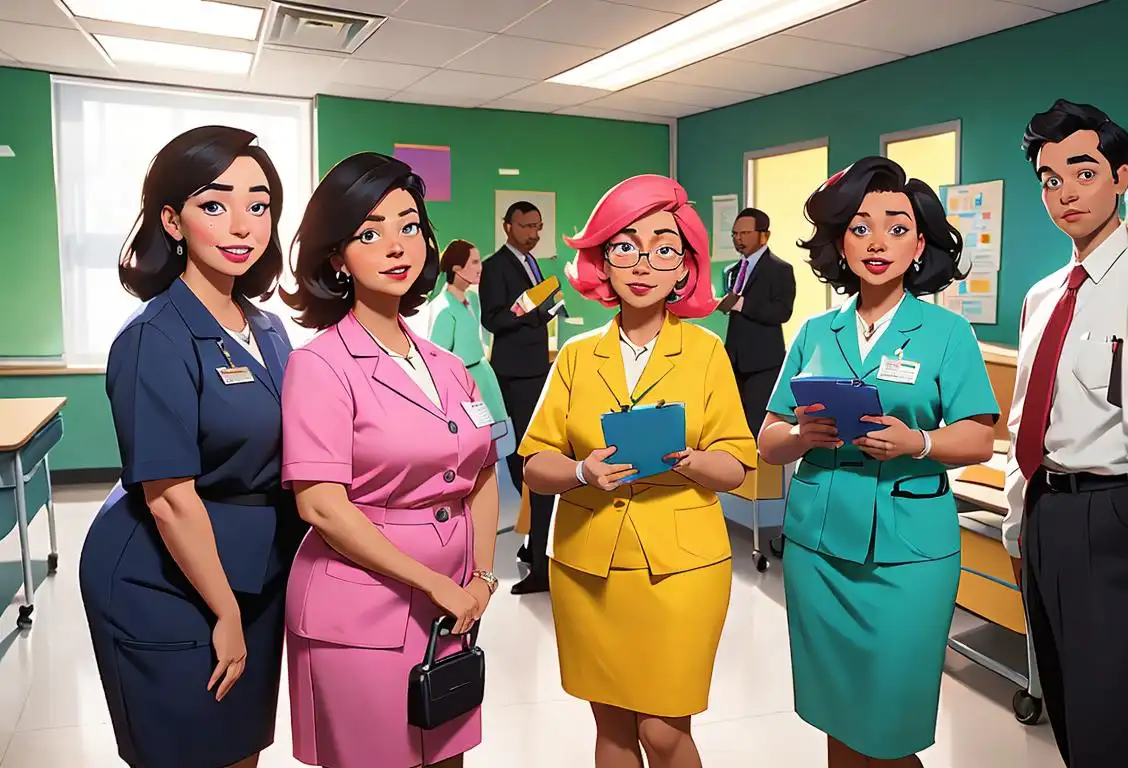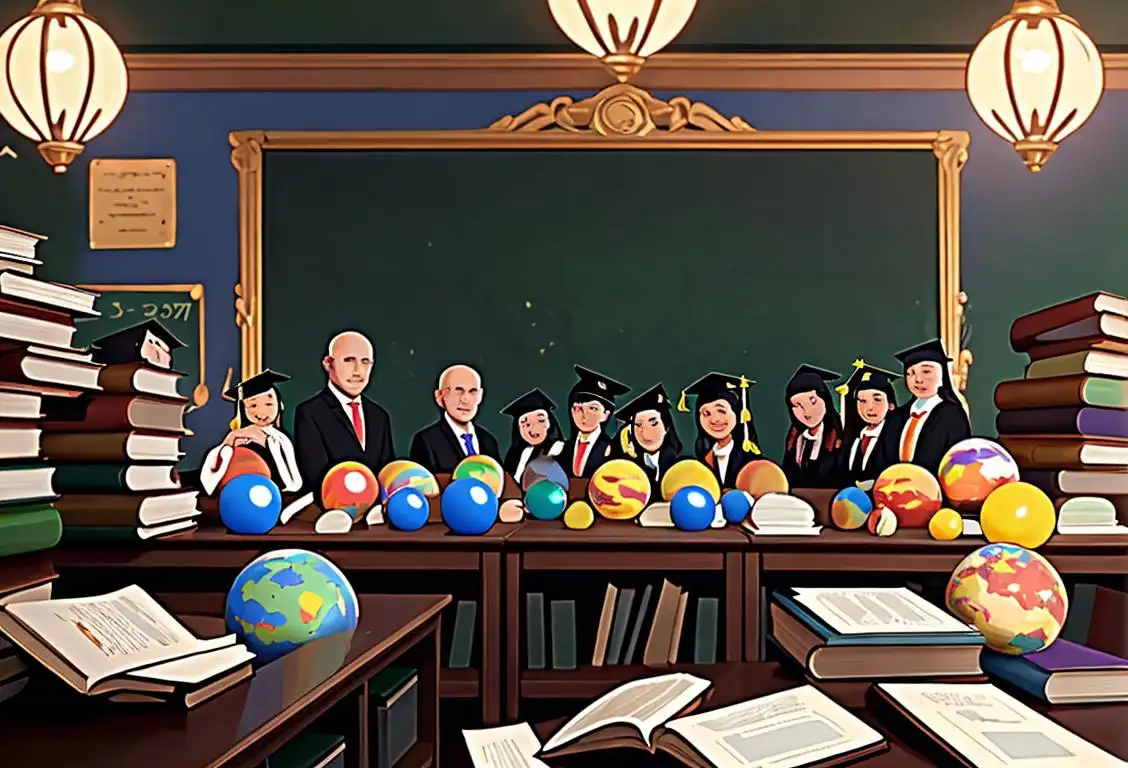National Paraprofessionals Day

Hey there, internet explorers! Are you ready to dive into the fascinating world of National Paraprofessionals Day? Grab your virtual snorkels, because we're about to take a deep dive into the origin and celebration of this marvelous day!
When is Paraprofessionals Day?
It's national paraprofessionals day on the 1st April.
What is National Paraprofessionals Day?
Ah, the unsung heroes of the education world! National Paraprofessionals Day is a special occasion dedicated to recognizing and honoring the invaluable contributions made by paraprofessionals in classrooms across the country. These dedicated individuals provide vital support to teachers, helping with various tasks such as assisting students with special needs, organizing classroom activities, and offering one-on-one support to help students succeed.
Paraprofessionals, also known as teacher's aides or education assistants, play a crucial role in creating a positive and nurturing learning environment for students. Their dedication, patience, and commitment deserve to be celebrated and appreciated!
The Internet History of National Paraprofessionals Day
The origins of National Paraprofessionals Day can be traced back to our good ol' friend, the internet. Although the exact details of its inception are a bit hazy, we can assume that someone, somewhere, had a lightbulb moment and realized the importance of dedicating a day to honor these unsung heroes.
Once the idea took hold, it quickly spread across various online platforms, with people sharing heartfelt stories of the impact paraprofessionals had on their lives or their children's lives. Social media became abuzz with appreciation posts, grateful messages, and even funny memes featuring paraprofessionals.
Soon enough, National Paraprofessionals Day gained recognition and support from schools, educational organizations, and communities. It became a day to not only highlight the crucial role paraprofessionals play in education but also to express gratitude for their unwavering dedication.
How to Celebrate National Paraprofessionals Day
Now that you know all about National Paraprofessionals Day, you're probably wondering how to celebrate it, right? Well, fear not! We've got some fabulous ideas to help you show your appreciation for these incredible individuals:
- Write a heartfelt thank-you note or e-card to a paraprofessional who made a positive impact in your life or your child's life.
- Organize a surprise celebration or a small gathering (virtually or in person, depending on the circumstances) to honor the paraprofessionals in your community.
- Donate school supplies or books to your local school or educational institution in honor of paraprofessionals.
- Create a social media campaign using the hashtag #ParaprofessionalsRock to spread awareness and appreciation.
Remember, it's the little gestures that can make a big difference in someone's day, so don't shy away from expressing your gratitude!
Fun Fact about National Paraprofessionals Day
Did you know that paraprofessionals wear many hats? Not literally, of course (that would be quite the fashion statement), but metaphorically speaking! From academic support to emotional guidance, paraprofessionals provide multifaceted assistance to students, helping them navigate the exciting (and sometimes challenging) world of education.
History behind the term 'Paraprofessionals'
1940
The Birth of the Paraprofessional Role
In the 1940s, the term 'paraprofessional' first came into existence. It was used to describe individuals who worked in supportive roles in various professions such as teaching and healthcare. These individuals had specialized skills and knowledge but did not hold professional degrees.
1960
Rise of Special Education
In the 1960s, there was a significant increase in the number of children with disabilities being educated in public schools. This led to the emergence of a new role within the education system.
1960
Emergence of paraprofessionals
The term 'paraprofessional' made its first appearance in the 1960s. It was initially used to describe individuals who worked in various professional capacities without having formal professional qualifications. These individuals performed supportive roles and provided valuable assistance to professionals in their respective fields.
1966
Introduction of the term 'paraprofessional'
The term 'paraprofessional' first emerged in 1966 as a way to describe a category of workers who assist professionals in various fields. The prefix 'para-' means 'beside' or 'alongside,' indicating that paraprofessionals work alongside professionals, providing support and assistance. This term was initially used in the education sector to refer to individuals who aided teachers in their classrooms.
1868
Emergence of 'para-'
The term 'paraprofessionals' traces its roots back to 1868 when 'para-' was first introduced into the English language. Derived from the Greek word 'para,' which means 'beside' or 'alongside,' 'para-' is often used as a prefix to denote a subsidiary or assisting role.
1962
Emergence of paraprofessionals
Paraprofessionals, also known as paraeducators, made their first appearance in the United States in 1962. This term was coined to describe individuals who work in positions that require specialized knowledge and skills, but do not meet the qualifications of a fully licensed professional. These individuals provide invaluable support to teachers and other professionals in educational, healthcare, and social service settings. The role of paraprofessionals has since expanded to various fields, including legal, engineering, and technology sectors.
1970
Expansion of paraprofessionals in education
During the 1970s, paraprofessionals gained more recognition and responsibilities in the field of education. With the implementation of various educational reforms, including the Title I program aimed at providing assistance to disadvantaged students, the demand for paraprofessionals increased. Paraprofessionals began taking on roles such as classroom aides, tutors, and intervention specialists, providing valuable support to both students and teachers.
1940s
Integration of 'paragovernmental' term
In the 1940s, the term 'paragovernmental' gained popularity. It referred to organizations or entities that operated alongside or in cooperation with the government, providing additional services and support. This usage of 'para-' provided a foundation for the later use of 'paraprofessionals.'
1960
Expanding Paraprofessional Roles in Education
During the 1960s, the term 'paraprofessional' gained popularity within the field of education. With increasing demands in schools and a shortage of fully qualified teachers, paraprofessionals were employed to assist in classrooms. They provided support to teachers, worked with students individually or in small groups, and helped with administrative tasks.
1978
Recognition and regulation
In 1978, the U.S. Congress passed the Individuals with Disabilities Education Act (IDEA) which increased the demand for paraprofessionals in special education settings. Under IDEA, paraprofessionals were officially recognized as essential members of the educational team, assisting students with disabilities in achieving their full potential. This recognition led to the establishment of standards and regulations for hiring, training, and supervision of paraprofessionals, ensuring they meet the specific needs of students and maintain professional ethics.
1970
Expanding roles and recognition
In the 1970s, the concept of paraprofessionals gained more recognition as their roles expanded across different industries. Educational institutions started employing paraprofessionals to assist teachers in classrooms, providing additional support to students with special needs. The increased recognition of their significant contributions led to the establishment of specific job titles and responsibilities for paraprofessionals.
1961
Introduction of Paraprofessionals
In 1961, the term 'paraprofessional' was first used to describe the individuals who provided support and assistance to students with disabilities in schools. These individuals worked under the supervision of certified teachers and helped in implementing educational programs.
1950s
Inclusion of 'paraprofessionals' in education
In the 1950s, the term 'paraprofessionals' emerged within the field of education. It was used to describe individuals who provided supplemental assistance to teachers, supporting classroom activities and student development. This recognition highlighted the valuable role played by these non-teacher professionals.
1980
Legal frameworks and certifications
During the 1980s, the importance of paraprofessionals in various fields led to the development of legal frameworks and certification programs. These frameworks aimed to establish guidelines and standards for paraprofessionals, ensuring that they possessed the necessary skills and knowledge to carry out their roles effectively. Certifications became available in education, healthcare, social work, and other industries.
1980s
Diversification of paraprofessional roles
In the 1980s, the role of paraprofessionals expanded beyond the realm of education and entered various other professional sectors. Paraprofessionals started serving in healthcare, social work, legal services, and other fields. Their responsibilities varied depending on the sector, but they commonly assisted professionals in their respective fields, contributing to the smooth operation of their work.
1975
Passage of the Education for All Handicapped Children Act
The passage of the Education for All Handicapped Children Act (now known as the Individuals with Disabilities Education Act) in 1975 further solidified the need for paraprofessionals in the field of special education. This law mandated that all students with disabilities receive a free appropriate public education in the least restrictive environment.
1991
Expanding roles and job titles
As the field of education evolved, paraprofessionals began to take on more diverse roles. In 1991, the National Resource Center for Paraprofessionals in Education and Related Services was established to provide support and resources for paraprofessionals and their employers. This organization played a significant role in expanding the understanding of paraprofessionals' capabilities and advocating for their professional development. Consequently, the job titles for paraprofessionals became more specific, reflecting their specialized skills and responsibilities, such as teacher assistants, instructional aides, and occupational therapy assistants.
1970
Federal Recognition of Paraprofessionals
In 1970, the U.S. government recognized the importance of paraprofessionals in the education system and established the Title I program as part of the Elementary and Secondary Education Act. This program aimed to improve the educational opportunities for disadvantaged students, and paraprofessionals played a crucial role in its implementation.
2001
Formal recognition of paraprofessional credentials
In 2001, the Council for Exceptional Children (CEC) and the National Resource Center for Paraprofessionals developed a national certification program for paraprofessionals. This program established formal recognition of paraprofessionals' competency and expertise in the field of special education. Obtaining certification became an important milestone for paraprofessionals, demonstrating their commitment to professionalism and their dedication to improving outcomes for students with disabilities.
1980s
Expansion of Paraprofessional Roles
During the 1980s, the role of paraprofessionals expanded beyond special education to include various fields such as healthcare, social work, and administrative support. Paraprofessionals became valuable assets in providing direct services and enhancing the quality of care and education.
1980
Professional Development for Paraprofessionals
During the 1980s, the focus shifted towards providing professional development opportunities for paraprofessionals. Training programs and workshops were designed to enhance their skills and knowledge, allowing them to better support educators and students. This recognition of paraprofessional contributions further solidified their role in various fields.
1990
Growing demand and professionalization
In the 1990s, the demand for paraprofessionals continued to grow as their contributions became increasingly valued. Paraprofessionals started assuming more specialized roles and taking on complex tasks, further blurring the lines between professional and paraprofessional work. This period marked the beginning of professionalization within the paraprofessional field.
1990s
Recognition of paraprofessionals' vital contributions
During the 1990s, the valuable contributions of paraprofessionals started gaining more recognition. Their role in supporting professionals and clients/patients became increasingly acknowledged, leading to initiatives aimed at professional development and training for paraprofessionals. Organizations and institutions began offering certifications and specialized programs to enhance the skills and knowledge of paraprofessionals, ensuring their competence in their respective domains.
1970s
Wider recognition and professionalization
During the 1970s, the term 'paraprofessionals' began to gain wider recognition, and efforts were made to professionalize the role. Training programs were established to enhance their skills, and their importance within various sectors, such as healthcare and social services, became more acknowledged.
2000
Integration of technology
With the advent of the new millennium, paraprofessionals adapted to the changing landscape by embracing technology. They became proficient in utilizing various digital tools and software programs to enhance their efficiency and effectiveness in supporting professionals. This technological integration further solidified the importance of paraprofessionals in a wide range of industries.
1990
Recognition of Paraprofessionals' Contributions
In 1990, the National Resource Center for Paraprofessionals in Education and Related Services was established to recognize and support the contributions of paraprofessionals in the field of education. This organization aimed to enhance the knowledge and skills of paraprofessionals through professional development opportunities.
Present
Diverse roles and impact
Today, paraprofessionals are found in diverse fields, including education, healthcare, social work, and legal services. They play crucial roles in assisting professionals, delivering direct services, and supporting various tasks within their respective domains. The term 'paraprofessionals' continues to evolve as society recognizes the value and impact of these integral auxiliary roles.
2000
Diversification of Paraprofessional Roles
As the 21st century began, the role of paraprofessionals expanded beyond education and healthcare. They became invaluable assets in fields such as social work, counseling, and technology. The diverse skill sets of paraprofessionals allowed professionals in these domains to focus on their core responsibilities while relying on their support.
Present
Continued growth and importance of paraprofessionals
In the present day, paraprofessionals continue to play a crucial role in various industries. Their diverse skills and expertise contribute to the efficient functioning of organizations and the well-being of individuals they serve. Paraprofessionals provide essential support to professionals, helping to bridge gaps in service and meet the needs of clients or patients. Their contributions are widely appreciated, and the term 'paraprofessional' has become firmly established in the lexicon of several fields.
Present
Diverse roles and continued growth
In the present day, paraprofessionals play diverse roles across numerous sectors, including education, healthcare, social services, and administration. Their contributions are invaluable in providing much-needed assistance and support, allowing professionals to focus on their specialized areas. As industries continue to evolve, paraprofessionals are likely to experience further growth and gain recognition for their essential role in the workforce.
Present
Integral Part of the Workforce
Today, paraprofessionals continue to play an integral role in various fields, working alongside professionals to provide support, assistance, and valuable services to individuals in need. Their contributions have proven to be essential in promoting inclusivity and ensuring the well-being of diverse populations.
Did you know?
Did you know that paraprofessionals wear many hats? Not literally, of course (that would be quite the fashion statement), but metaphorically speaking! From academic support to emotional guidance, paraprofessionals provide multifaceted assistance to students, helping them navigate the exciting (and sometimes challenging) world of education.Tagged
appreciation education supportFirst identified
1st April 2020Most mentioned on
1st April 2020Total mentions
19Other days
Paraprofessionals Day
Paraprofessionals Appreciation Day
Paraprofessional Day
Superintendent Of The Year Becomes Teacher For A Day
Teacher Day
Teacher Appreciation Day
Programmers Day
Transgender Hiv Testing Day
School Librarian Day
Abortion Providers Appreciation Day








